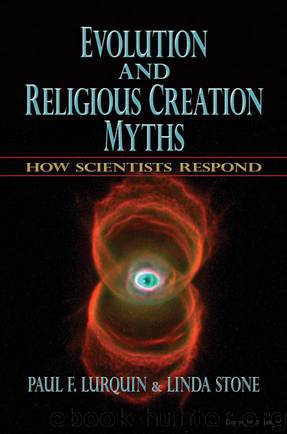Evolution and Religious Creation Myths: How Scientists Respond by Paul F. Lurquin & Linda Stone

Author:Paul F. Lurquin & Linda Stone [Lurquin, Paul F. & Stone, Linda]
Language: eng
Format: epub
ISBN: 9780195315387
Amazon: 0195315383
Publisher: Oxford University Press, USA
Published: 2007-07-06T10:00:00+00:00
The Origins and Evolution of Homo sapiens 107
Nonetheless, the Puritans were successful in America, so much so that many aspects of original Puritanism (such as work ethic and deep religiosity) still exist today in our society. And this happened in spite of the later immi-gration of millions of people who did not share the beliefs of the Puritans.
Thus, America as a whole culturally drifted in the direction of a more fundamentalist interpretation of religion while Europe kept its more casual approach.
The theory of co-evolution is not based on anecdotal evidence alone, as presented here for reasons of simplicity. It has become very mathematical and oriented toward population genetics. It is a young theory that needs to be buttressed by a considerable amount of evidence.
In conclusion, paleontology and genetics strongly agree that modern humans appeared in East Africa more than 100,000 years ago and colonized Earth over tens of thousands of years. These dates, as well as the scenario of human migrations provided by science, are irreconcilable with literally interpreted biblical accounts in Genesis. Both views cannot be correct at the same time. Further, our genes and our cultures co-evolve in a constant interplay that can be studied naturalistically by social scientists. This means that there is no such thing as an immutable human essence (or absolute value) created once and for all, as implied by the Great Chain of Being and its theological underpinnings (described in chapter 2).
By definition, classical creationists and neocreationists must reject the theory of human evolution as presented above since natural selection and drift (chance) are involved. But then, rejecting these scientific findings and future analyses in a creationist or neocreationist fashion is equivalent to rejecting all of science, because both paleontology and genetics (and now even cultural anthropology) rely heavily on the sciences of chemistry, geology, physics, and their mutually supportive theories. Is rejecting the totality of science an option? Science—as long as it is not applied to questions of evolution, particularly human evolution—usually does not elicit much controversy among the public. And science works—without it, there would be no antibiotics, no television, no cars, no plastics, and no computers, just to name a few. Why, then, should science not work for investigating our human origins in a squarely evolutionary fashion? This attitude does not make sense.
To conclude this chapter, we would like to remind skeptical readers of the television show Crime Scene Investigation (CSI) and soap operas such as One Life to Live. In these entertaining series, the DNA technology used to catch criminals and determine fatherhood is the same as that used in real life, and what is more, it is the exact same technology used to study mtDNA and Y
chromosome DNA to establish patterns of human evolution in particular, and all of evolution in general. If this DNA technology can be trusted well 108
Evolution and Religious Creation Myths
enough to convict dangerous criminals and specify whose father is who, it should be just as trustable when applied to evolution, should it not?
We describe
Download
This site does not store any files on its server. We only index and link to content provided by other sites. Please contact the content providers to delete copyright contents if any and email us, we'll remove relevant links or contents immediately.
The Lost Art of Listening by Michael P. Nichols(7388)
Why I Am Not A Calvinist by Dr. Peter S. Ruckman(4088)
The Rosicrucians by Christopher McIntosh(3455)
Wicca: a guide for the solitary practitioner by Scott Cunningham(3117)
Signature in the Cell: DNA and the Evidence for Intelligent Design by Stephen C. Meyer(3055)
Real Sex by Lauren F. Winner(2950)
The Holy Spirit by Billy Graham(2880)
To Light a Sacred Flame by Silver RavenWolf(2757)
The End of Faith by Sam Harris(2676)
The Gnostic Gospels by Pagels Elaine(2459)
Waking Up by Sam Harris(2380)
Nine Parts of Desire by Geraldine Brooks(2313)
Jesus by Paul Johnson(2294)
Devil, The by Almond Philip C(2266)
The God delusion by Richard Dawkins(2251)
Heavens on Earth by Michael Shermer(2225)
Kundalini by Gopi Krishna(2128)
Chosen by God by R. C. Sproul(2113)
The Nature of Consciousness by Rupert Spira(2034)
